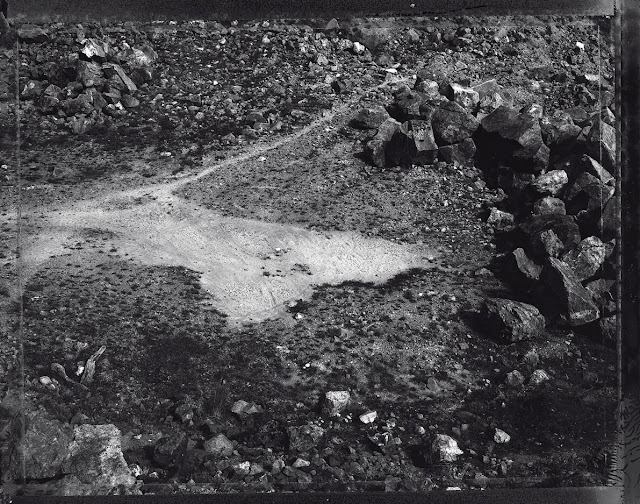Exhibition Review: Lesley Punton, Below, the rocks plunged into darkness, Studio Pavillion at House for an Art Lover
Strontian/Pb
Lesley Punton’s Below, the rocks plunged into darkness meditates on time and light, the naming and physical experience of encountering mountains and the stories embodied by rocks one might hold in the hand. The work is varied in its forms: video, photography, drawing and painting, text and…. twenty-six fascinating rocks (and a bonus crystal).
Travelling around the gallery in a clockwise direction, the wall on the left holds photographic works referring to darkness and light but also a Platinum print proposing that: “Remoteness is a medium of clarification”. On the middle wall is an exquisite, selenium toned, silver gelatin print of Strontian made from a Polaroid negative. Strontian is a place, a chemical element, and a pivotal childhood memory for Punton that helped nurture her love of the physical stuff of the earth. In the bay of a large window there is a copy of the artist’s book Upland Birds. At first this seems slightly incongruous but again and again a viewer chooses to pick up the book and sit on the window ledge and read. A point at which to pause and reflect is a metaphor for the exhibition itself.
In a corner of the room on a smaller window ledge stands a tiny Sgurr or mountain of silicon carbide, material for bulletproof vests and the mirrors in astronomical telescopes. Along the wall on the right of the room are a series of text paintings where the Gaelic names of mountains are reflected by the colours of the paintings themselves. The light grey of Beinn a’ Ghlo (misty mount) contrasts with Meall Buidhe (yellow hill) and so on. The final wall work consists of two digital super 16mm films looping on a small tablet to the sound of birds. The film titles A Darkening and The Hide allude to the passing of day into night and an actual ‘hide’ from which to view nature without disturbing it.
Schaft/chas
All of the work in the exhibition is relatively small in size save for one large photograph of a rock face into which a shaft has been mined, and a wall map of the contents of a vitrine. The vitrine stands on trestles in the middle of the gallery and is filled with a Collection of rocks. On the floor of the gallery is a stack of A2 information sheets, a version of the rock map for the viewer to take and read. This map contains twenty-eight short texts, one for each rock and two referring to mysterious places where no stone was collected, perhaps places we must now visit for ourselves, (Glen Roy and The Fossil Grove). Rock 22, a small piece of Gabbro, comes from the Black Cuillin Ridge on Skye where, we are told, compass navigation becomes slightly unpredictable due to the magnetic properties of the rock underfoot.
Collection
The Collection has magnetic properties of its own. Visitors circulate around the space looking at the works on the walls but afterwards almost inevitably gravitate towards the Collection where, map in hand, they match each rock to the outlines on their sheet and to the corresponding anecdotes. Who knew that the sand-mines of Lochaline yielded some of Earth’s purest of sandstones, shipped around the world as an essential tool in the manufacture of camera lenses and other optical instruments? And how on earth did Lesley Punton lay her hands on fragments of meteorites recovered from the Sahara and Guangxi? Sea coal, Muscovite, graphite, pure white chalk, obsidian, iron pyrites, it is all there, but it is not ‘fools gold’. The Collection is real treasure both for the intellect and the senses, it is the stuff that mountains and memories and paint pigments and scientific knowledge are made from. These rocks measure time in millions, sometimes billions of years.
The work follows in the tradition of British land art where text and images and geological objects convey the experience of walking and being in a landscape rather than literally describing or representing it. The quiet, contemplative, journey through the light filled space of this exhibition returns us to “Remoteness is a medium for clarification”. The effect of all this visual, textual and physical matter is to transport us to other places, remote places where minerals and crystals can be collected and where one can be in landscapes that are not filled with digital devices and the data they pour over us and suck out of us, places where we are confronted with nature and ourselves as we are.
All images © Lesley Punton
All images © Lesley Punton






Comments
Post a Comment